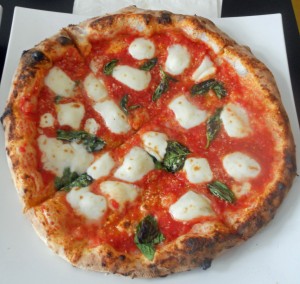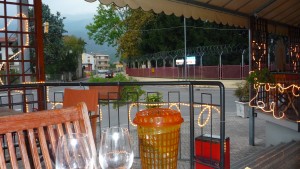I found this article published today on the web. It is written by Alia Hoyt and is excellently done! Enjoy
Pizza is one of the most popular foods on the planet. In fact, it’s so popular that you would think it has been around forever. But actually, it’s relatively new to the stomachs of the Americans who treasure it.
Despite its relatively short tenure in the United States, pizza has become a staple in the diets of many. In fact, it’s so beloved that each person in North America puts away an average of 23 pounds of it each year [source: Domino’s Pizza]. More than 3 billion pizzas a year are sold in the United States alone, resulting in about $37 billion in revenue, according to the National Association of Pizza Operators.
The beauty of pizza is that, no matter what your tastes, there are so many ways to make it and so many topping possibilities that virtually anyone can create a pizza to suit himself. Not too keen on cheese? Just sprinkle it on or leave it off entirely! Can’t decide between macaroni and cheese and pizza? That’s OK — some places actually serve the two kid-friendly dishes combined!
In its simplest form, pizza consists of three main ingredients: bread, tomato sauce and cheese, but the options are almost limitless from there. In this article you’ll learn more than you ever thought you could about pizza, including its history in Italy and the United States, how dough is made, and topping trends around the globe.
We’ll also describe in mouthwatering detail the different types of pizza and what makes each of them special. And you might want to keep a phone handy — in case you’re tempted to order one while reading this.
Italians are usually credited with the development and spread of pizza around the world. Much of that credit is accurate, but the concept of putting stuff on hot bread probably dates back to the days of cavemen. Actual pizza probably made its debut in ancient Greece. The Greeks baked round flatbreads (similar to what we know today as foccacia bread) that they decorated with a variety of spices, seasonings, oils and other toppings.
The word “pizza,” meaning “pie,” was coined sometime around A.D. 1000 near Rome and Naples, Italy. In the 18th century, flatbread pizza became a popular and cost-effective meal for the peasant population in Naples. People were just beginning to realize that tomatoes, which had been brought over from the New World in the 16th century, were actually not poisonous. By the end of the 18th century, the residents of Naples — and tourists — began to top the bread with tomatoes, essentially creating pizza as we know it. Street vendors sold the dish in the poor areas of Naples before the opening of the world’s first pizzeria, Antica Pizzeria Port’Alba, in 1830. And pizza is sold today from the very same spot.
The Pizza Industry
Although the product may not closely resemble the pizza that originated in Italy, pizza delivery and dine-in chains are wildly popular. Some quick facts:
Pizza Hut is the largest chain pizza restaurant in the world. The company has nearly 6,600 locations in the United States and more than 4,000 in 100 other countries.
Domino’s Pizza leads the market in delivery. The company boasts about 9,000 stores in more than 55 countries.
Papa John’s, despite being a relative newcomer to the industry, is the third-largest pizza company in the world.
[sources: Pizza Hut, Papa John’s, Domino’s]
Sometime around 1889, Italy’s royal couple, Queen Margherita and King Umberto I, toured their kingdom. The Queen took note of the large, flat bread being consumed. She tried it and loved it. She called Chef Rafaelle Esposito to her palace, where he created a variety of pizzas for her. In honor of her, he designed a pizza with toppings in the colors of the Italian flag (red tomatoes, white mozzarella and green basil). This pizza became her favorite and is known to this day as the Margherita. Her love for pizza made her incredibly popular among her subjects — most royals would never have dined on peasant food, much less encourage its spread [source: A Full Belly].
Pizza appeared on the American scene quietly in the late 19th century with the mass arrival of Italian immigrants. It was mostly sold on the streets of large Italian neighborhoods in such cities as Philadelphia, Chicago and New York City. Pizza soon became available in cafes and grocery stores, but it pretty much remained exclusive to Italian neighborhoods until after World War II. At this time, soldiers returning from Italy increased demand for the dish. Pizza’s popularity spread like wildfire, and pizzerias began popping up all over the United States, followed quickly by chain restaurants like Shakey’s Pizza and Pizza Hut.
Everybody Loves Ray’s Pizza
Apparently, pizza tastes better when it’s made by a guy named Ray. At least that’s what New Yorkers seem to think — more than 30 pizzerias use the name “Ray” in New York City alone. Here is a brief timeline of the Ray trend:
Ralph Cuomo opened Ray’s in 1959 in Little Italy.
He opened another on 54th Street and Seventh Avenue in the early 1960s.
Rosolino Mangano bought the second Ray’s and changed the name to Famous Original Ray’s, even though it wasn’t technically the original.
Mangano, who now goes by “Ray” himself, opened up more Famous Original Ray’s across the city.
Mangano sold a store to a new owner, who began using other variations of the Ray name in his stores.
Cuomo decided to trademark the name (he had to have been in cahoots with the other two owners in order to make this happen, though).
The three Rays went after other people using the name, including Joe Bari, who had operated Ray Bari Pizza since 1973. It’s now called RayBari Pizza.
[source: A Full Belly]
The Dough
Accomplished pizza chefs consider the dough-making process an art form. The specifics of dough-making vary depending on whether the final goal is a thin, crispy crust or a thick, soft one. The mandatory ingredients in pizza dough are flour, water and yeast. Shortening, salt and sugar are also included in many basic recipes. These extras provide more taste and texture options.
Flour is the “meat” of the dough recipe. Chefs use high-gluten flour because gluten makes the crust tough enough to stand up to the water and other ingredients.
Water is vital to the recipe because it brings all the ingredients together. It encourages the production of gluten and works with starch in the flour to bind the gluten. This is what makes a pizza crust nice and firm. The amount of water used in a pizza dough recipe varies. The dough can be made to be pliable or stiff, as desired by the chef.
Without yeast, pizza crusts would lose pretty much all texture and softness. Yeast, a leavening agent, makes the dough rise. A living, single-celled plant from the fungi family, it ferments (digests) sugars and starches. Fermentation causes the dough to rise by trapping gas bubbles inside it. It also makes the dough more pliable and easy to maneuver.
Salt provides extra flavor. It also slows the fermentation process.
Shortening increases the pliability and moisture of the dough by providing lubrication. Some chefs use canola or olive oil to add a little extra flavor.
The amount of sugar changes the fermentation rate. More sugar equals quicker fermentation. Sugar also helps the crust to brown and keeps water inside the crust.
Mixing: Blend dry ingredients with a mixer. Dissolve yeast and sugar in water and add to the mixture. Mix until dough “slaps” the sides of the mixing bowl. At this point, the dough should look nice and smooth, not wet and sticky.
Balling: Use your hands to roll balls of dough. The skin should be tight, not cracked. Place balls on an oiled sheet pan.
Proofing: Cover the dough with wax paper and let it sit at room temperature until it doubles in size.
Retarding: Place the dough balls in the refrigerator for at least 12 hours to slow yeast activity.
If these steps are completed properly, the dough stays usable for approximately three to five days.
Unconventional Pizzas — Creative or Just Silly?
We know that taste buds vary. Otherwise, there would be no place for the minced mutton on pizzas in India. Other than the Italian law governing the purity of Neopolitan pizza, there don’t seem to be any rules in the pizza industry. But do so-called “unconventional” pizzas even qualify as pizza? Probably not, if you want to be strict about the “bread, cheese and sauce” rule. However, if you don’t mind messing with tradition, you might enjoy some of these concoctions:
dessert pizzas with Oreos and chocolate-chip cookie dough
tiny bagel bites topped with minuscule amounts of cheese and toppings
macaroni-and-cheese pizzas
Mexican pizzas — thin tortilla crusts topped with re-fried beans, cheese and olives
Baking
You can bake pizza in a variety of ovens. Chefs use a peel, a long, paddle-like utensil, to slide pizzas into electric deck ovens. The pizza is baked directly on a screen or hot bricks. Conveyor belt ovens are used primarily in large chain restaurants. Gas canister ovens position stone bricks directly above the heat source. “Brick-oven pizzerias” use coal or wood-fired brick ovens, which often lend a smokier taste.
Sauce and Cheese
Pizza sauce is usually tomato-based. However, the list of unconventional pizza sauces includes pesto, Alfredo, ketchup and barbecue. “White pizza” recipes often eliminate the sauce entirely, replacing it with garlic butter.
Traditional pizza is made with mozzarella cheese sprinkled on tomato sauce. Many chefs like to experiment with blends of cheeses, herbs and seasonings like oregano and basil.
Pizza Styles
Americans eat almost
252 million pounds of pepperoni a year.
People have strong opinions about pizza — in terms of passion, it seems to rank right up there with politics and religion. Some pizza lovers treasure the taste of true Chicago-style pizza so much that they have it shipped across the country. Neapolitan pizza purists in Italy lobbied recently to pass a bill protecting the style and restricting pizza vendors from using the Neapolitan name unless they meet specific guidelines (see sidebar). But those of us who enjoy variety certainly have plenty of pizza styles to choose from, including:
Neapolitan: Features a very thin, bubbly crust. Basil and mozzarella do not cover the sauce, as is common in many American pizzas. Instead, they accent it. It is usually cooked in a brick or wood-fired oven.
New York: Also thin-crusted, an authentic New York pizza features sweet tomato sauce topped with a layer of cheese. New York pizza enthusiasts don’t ruin the purity of the slice by asking for a lot of toppings.
Chicago: The opposite of New York and Neapolitan pizzas in many ways, Chicago-style pizza boasts a thick crust that is baked in a pan, rather than directly on the bricks or on a sheet. The application of cheese and sauce is also reversed. Cheese goes on the bottom, followed by toppings. Sauce finishes off the creation, which is so thick that a fork and knife are necessary. Greek: Greek pizza is also baked in a pan. One trademark characteristic is an oily crust. It is often topped with traditional Greek toppings like spinach, feta cheese and olives.
California: Superthin crusts and seasonal toppings are trademark components of California-style pizzas. They’re typically topped with whatever veggies are in season in the Golden State.
thick square or rectangular crust. Toppings are placed on top of the dough. The version made in Sicily actually places the toppings, such as pecorino cheese and anchovies, inside the crust, rather than on top.
Topping Trends
It probably won’t come as much of a shock that pepperoni is the No. 1 pizza topping in America. According to the National Association of Pizza Operators (NAPO), Americans consume almost 252 million pounds of pepperoni every year. Other perennial favorites are extra cheese, sausage, mushrooms, green peppers and onions. Americans also enjoy ham, bacon, ground beef, chicken, artichoke hearts, bell peppers, eggplant, olives, spinach, tomatoes and broccoli.
On the flip side, NAPO reports that anchovies consistently maintain their place as the least popular pizza topping, although they are very popular in some countries. In fact, the world has decidedly eclectic taste in toppings.
India: pickled ginger, tofu and minced mutton
Russia: “mockba” (a blend of tuna, mackerel, sardines, onions and salmon)
Japan: squid and a combination topping called “mayo jaga” (mayonnaise, bacon and potato)
Brazil: green peas
Costa Rica: coconut [source: Domino’s Pizza]
Neapolitans Mean Business
Few foods have their own personal watchdog agency, so Neapolitan pizza must be pretty tasty! The True Neapolitan Pizza Association holds very strict pizza standards, recognizing only the Marinara (topped with tomato, garlic, oregano, extra virgin olive oil and sometimes basil) and the Margherita as authentic pizzas.
The Italian Ministry of Agricultural Politics recently passed a law governing how the pizzas must be made if they want to bear either of these names:
Must be round and no more than 13 ¾ inches in diameter
Center must be less than one-tenth of an inch tall
Crust must be three-quarters of an inch thick or less
Dough has to be kneaded entirely by hand
Must use very specific and traditional types of salt, flour, tomatoes and yeast
[source: MSNBC]
Most expensive: Scottish chef Domenico Crolla created the “Pizza Royale 007” (in honor of James Bond) for a fundraiser. It cost 3,000 euros ($4,437) and featured high-end toppings like edible gold, lobster marinated in cognac, champagne-soaked caviar, venison medallions and smoked salmon [source: BBC].
Most extravagant: Though it is hard to top Crolla’s creation, the “Luxury Pizza” at Nino’s Bellissima restaurant in New York City is covered with fresh lobster, crème fraiche, chives and six types of caviar. At $125 per slice and $1,000 per 12-inch pizza, this entree is certainly a delicacy [source: Reuters].
Largest ever made: According to Guinness World Records, this feat was accomplished on Dec. 8, 1990, in Johannesburg, South Africa. The pizza measured 122.7 feet (37.4 meters) in diameter and required 1,102 pounds (500 kilograms) of flour, 1,764 pounds (800 kg) of cheese and 1,984 pounds (900 kg) of tomato puree.
Largest ever made and eaten: Guinness World Records credits the city of Havana, Fla., with hosting this accomplishment on Oct. 11, 1987. The pizza tipped the scales at 44,457 pounds (20,165 kg). The pie was divided into 94,248 slices and devoured by 30,000-plus spectators.
Longest pizza delivery: Lucy Clough of Domino’s Pizza is arguably the world’s most dedicated pizza delivery person. On Nov. 19, 2004, she traveled 10,532 miles (16,950 kilometers) from London to Melbourne, Australia, to set the record for longest pizza delivery, as recognized by Guinness World Records.
To learn more about pizza, check out the links on the next page.
Domino’s Pizza Legends
If you visit urban legend Web site Snopes.com and type in “pizza,” you’ll notice that most of the results are related to Domino’s Pizza. Here is a rundown:
Legend: The “30 minutes or less and it’s free” promise was discontinued because a rushing delivery driver fatally hit a child with his car.
Truth: Domino’s reportedly settled out of court in a few cases involving automobile accidents with drivers, one of which killed a woman. Domino’s never said that the time limit was a factor and instead blamed weather and road conditions. The chain now emphasizes quality with the “Made Fresh, Arrives Fresh” guarantee.
Legend: Domino’s Pizza provides financial assistance to anti-abortion group Operation Rescue.
Truth: Domino’s does not contribute financially, but founder Tom Monaghan is a champion of pro-life causes. Monaghan doesn’t even own Domino’s anymore — he sold it in 1998 for $1 billion. Which brings us to our next legend…
Legend: The founder of Domino’s is building an all-Catholic town in Florida.
Truth: This one is actually right. Monaghan is currently heading up the development of Ave Maria, Fla., which is about 90 miles from Miami. The city will ban practices frowned upon by Catholicism, such as pornography, birth control and abortions. Eventually, the city will be home to more than 30,000 residents, including 5,000 students at a new Catholic university.
 On the recommendations of a friend and a few best pizza lists, My wife and I checked out Pupatella in Arlington, VA. Just outside DC, this authentic VPN (Verace Pizza Napoleta) and DOC certified casual restaurant has been said to pop out some of the best pies in town! With humble beginnings as a pizza cart at a nearby metro station, Pupatella had made a lot of fans before its doors even opened in mid 2010.
On the recommendations of a friend and a few best pizza lists, My wife and I checked out Pupatella in Arlington, VA. Just outside DC, this authentic VPN (Verace Pizza Napoleta) and DOC certified casual restaurant has been said to pop out some of the best pies in town! With humble beginnings as a pizza cart at a nearby metro station, Pupatella had made a lot of fans before its doors even opened in mid 2010.  Pupatella is a casual dining experience. Each diner grabs their own utensils, picks their own table, orders at a counter, drinks from a bottled soda, beer, or wine, and clears their own table. No reservations are accepted so expect a wait if you come during peak hours. Believe me though, it’s worth the wait!
Pupatella is a casual dining experience. Each diner grabs their own utensils, picks their own table, orders at a counter, drinks from a bottled soda, beer, or wine, and clears their own table. No reservations are accepted so expect a wait if you come during peak hours. Believe me though, it’s worth the wait!




![Reblog this post [with Zemanta]](http://img.zemanta.com/reblog_e.png?x-id=5a265145-f217-4a15-991c-8d3b72b4336e)

